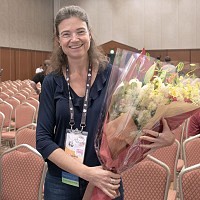Cristine Hoepers joined CERT.br, the Brazilian National CERT maintained by NIC.br, in 1999 and in 2000 attended the FIRST Conference for the first time. Since then, she has volunteered with several FIRST initiatives. She has been an active participant on the Membership Committee and has supported the implementation of SIM3 into FIRST processes (and is a SIM3 Auditor). She has participated in the CSIRT Framework SIG and helped develop the FIRST CSIRT Services Framework. She served on the FIRST Board of Directors in 2012/2013 and was one of the very first people to start advocating for cybersecurity incident response as a voice in internet governance and policy discussions. Without her pushing forward the very first steps, FIRST would never have engaged in forums such as the IGF and brought incident response to this policy community.
During her time at CERT.br she started a CSIRT development program which kicked off the very active development of CSIRTs in Brazil, providing CSIRT training in partnership with the CERT® Division/SEI/CMU, helping to establish CSIRTs throughout Brazil, Latin America and beyond.
She also started researching the use of honeypots for incident detection during her Ph.D. and participated in the conception and deployment of a countrywide network of honeypots in Brazil. She also published several papers sharing knowledge from the incident response (and most specifically FIRST) community, such as in the GFCE magazine, the OECD's Digital Economy papers on measuring digital security risk management, RFC 8073, the SEI State of Practice of Computer Security Incident Response Teams, GFCE Getting Started with a National CSIRT, and many more.
From 2006 to 2013 Cristine was one of the leaders of an initiative to reduce spam in Brazil by actively having network providers adopt port 25 management, and in 2020 she received from the Malware and Mobile Anti-Abuse Working Group (M3AAWG) the annual Mary Litynski Award for her work to reduce Internet abuse and increase Internet resilience. She was a member of the ITU HLEG (High Level Experts Group), and a speaker and moderator at ITU, OAS, ICANN, APWG, IGF, MAAWG, LACNIC and FIRST events.









